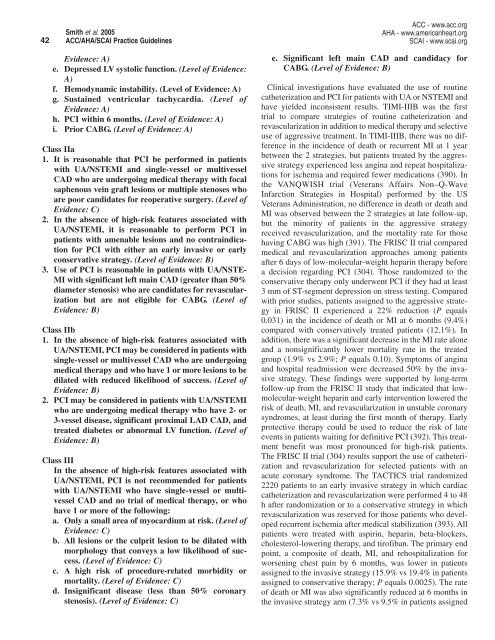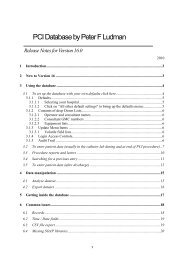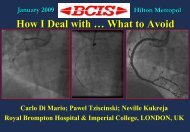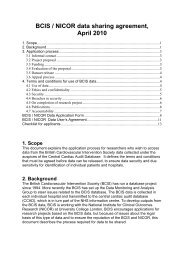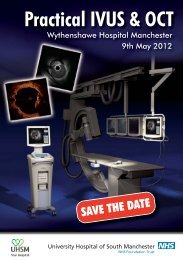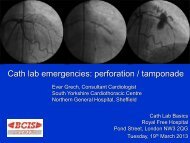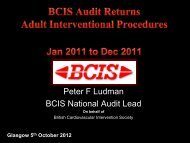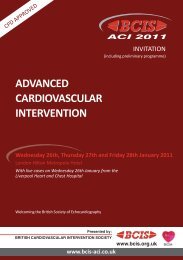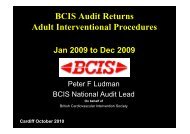Recommendations
ACC/AHA/SCAI PCI Guidelines - British Cardiovascular Intervention ...
ACC/AHA/SCAI PCI Guidelines - British Cardiovascular Intervention ...
- No tags were found...
Create successful ePaper yourself
Turn your PDF publications into a flip-book with our unique Google optimized e-Paper software.
42<br />
Smith et al. 2005<br />
ACC/AHA/SCAI Practice Guidelines<br />
ACC - www.acc.org<br />
AHA - www.americanheart.org<br />
SCAI - www.scai.org<br />
Evidence: A)<br />
e. Depressed LV systolic function. (Level of Evidence:<br />
A)<br />
f. Hemodynamic instability. (Level of Evidence: A)<br />
g. Sustained ventricular tachycardia. (Level of<br />
Evidence: A)<br />
h. PCI within 6 months. (Level of Evidence: A)<br />
i. Prior CABG. (Level of Evidence: A)<br />
Class IIa<br />
1. It is reasonable that PCI be performed in patients<br />
with UA/NSTEMI and single-vessel or multivessel<br />
CAD who are undergoing medical therapy with focal<br />
saphenous vein graft lesions or multiple stenoses who<br />
are poor candidates for reoperative surgery. (Level of<br />
Evidence: C)<br />
2. In the absence of high-risk features associated with<br />
UA/NSTEMI, it is reasonable to perform PCI in<br />
patients with amenable lesions and no contraindication<br />
for PCI with either an early invasive or early<br />
conservative strategy. (Level of Evidence: B)<br />
3. Use of PCI is reasonable in patients with UA/NSTE-<br />
MI with significant left main CAD (greater than 50%<br />
diameter stenosis) who are candidates for revascularization<br />
but are not eligible for CABG. (Level of<br />
Evidence: B)<br />
Class IIb<br />
1. In the absence of high-risk features associated with<br />
UA/NSTEMI, PCI may be considered in patients with<br />
single-vessel or multivessel CAD who are undergoing<br />
medical therapy and who have 1 or more lesions to be<br />
dilated with reduced likelihood of success. (Level of<br />
Evidence: B)<br />
2. PCI may be considered in patients with UA/NSTEMI<br />
who are undergoing medical therapy who have 2- or<br />
3-vessel disease, significant proximal LAD CAD, and<br />
treated diabetes or abnormal LV function. (Level of<br />
Evidence: B)<br />
Class III<br />
In the absence of high-risk features associated with<br />
UA/NSTEMI, PCI is not recommended for patients<br />
with UA/NSTEMI who have single-vessel or multivessel<br />
CAD and no trial of medical therapy, or who<br />
have 1 or more of the following:<br />
a. Only a small area of myocardium at risk. (Level of<br />
Evidence: C)<br />
b. All lesions or the culprit lesion to be dilated with<br />
morphology that conveys a low likelihood of success.<br />
(Level of Evidence: C)<br />
c. A high risk of procedure-related morbidity or<br />
mortality. (Level of Evidence: C)<br />
d. Insignificant disease (less than 50% coronary<br />
stenosis). (Level of Evidence: C)<br />
e. Significant left main CAD and candidacy for<br />
CABG. (Level of Evidence: B)<br />
Clinical investigations have evaluated the use of routine<br />
catheterization and PCI for patients with UA or NSTEMI and<br />
have yielded inconsistent results. TIMI-IIIB was the first<br />
trial to compare strategies of routine catheterization and<br />
revascularization in addition to medical therapy and selective<br />
use of aggressive treatment. In TIMI-IIIB, there was no difference<br />
in the incidence of death or recurrent MI at 1 year<br />
between the 2 strategies, but patients treated by the aggressive<br />
strategy experienced less angina and repeat hospitalizations<br />
for ischemia and required fewer medications (390). In<br />
the VANQWISH trial (Veterans Affairs Non–Q-Wave<br />
Infarction Strategies in Hospital) performed by the US<br />
Veterans Administration, no difference in death or death and<br />
MI was observed between the 2 strategies at late follow-up,<br />
but the minority of patients in the aggressive strategy<br />
received revascularization, and the mortality rate for those<br />
having CABG was high (391). The FRISC II trial compared<br />
medical and revascularization approaches among patients<br />
after 6 days of low-molecular-weight heparin therapy before<br />
a decision regarding PCI (304). Those randomized to the<br />
conservative therapy only underwent PCI if they had at least<br />
3 mm of ST-segment depression on stress testing. Compared<br />
with prior studies, patients assigned to the aggressive strategy<br />
in FRISC II experienced a 22% reduction (P equals<br />
0.031) in the incidence of death or MI at 6 months (9.4%)<br />
compared with conservatively treated patients (12.1%). In<br />
addition, there was a significant decrease in the MI rate alone<br />
and a nonsignificantly lower mortality rate in the treated<br />
group (1.9% vs 2.9%; P equals 0.10). Symptoms of angina<br />
and hospital readmission were decreased 50% by the invasive<br />
strategy. These findings were supported by long-term<br />
follow-up from the FRISC II study that indicated that lowmolecular-weight<br />
heparin and early intervention lowered the<br />
risk of death, MI, and revascularization in unstable coronary<br />
syndromes, at least during the first month of therapy. Early<br />
protective therapy could be used to reduce the risk of late<br />
events in patients waiting for definitive PCI (392). This treatment<br />
benefit was most pronounced for high-risk patients.<br />
The FRISC II trial (304) results support the use of catheterization<br />
and revascularization for selected patients with an<br />
acute coronary syndrome. The TACTICS trial randomized<br />
2220 patients to an early invasive strategy in which cardiac<br />
catheterization and revascularization were performed 4 to 48<br />
h after randomization or to a conservative strategy in which<br />
revascularization was reserved for those patients who developed<br />
recurrent ischemia after medical stabilization (393). All<br />
patients were treated with aspirin, heparin, beta-blockers,<br />
cholesterol-lowering therapy, and tirofiban. The primary end<br />
point, a composite of death, MI, and rehospitalization for<br />
worsening chest pain by 6 months, was lower in patients<br />
assigned to the invasive strategy (15.9% vs 19.4% in patients<br />
assigned to conservative therapy; P equals 0.0025). The rate<br />
of death or MI was also significantly reduced at 6 months in<br />
the invasive strategy arm (7.3% vs 9.5% in patients assigned


